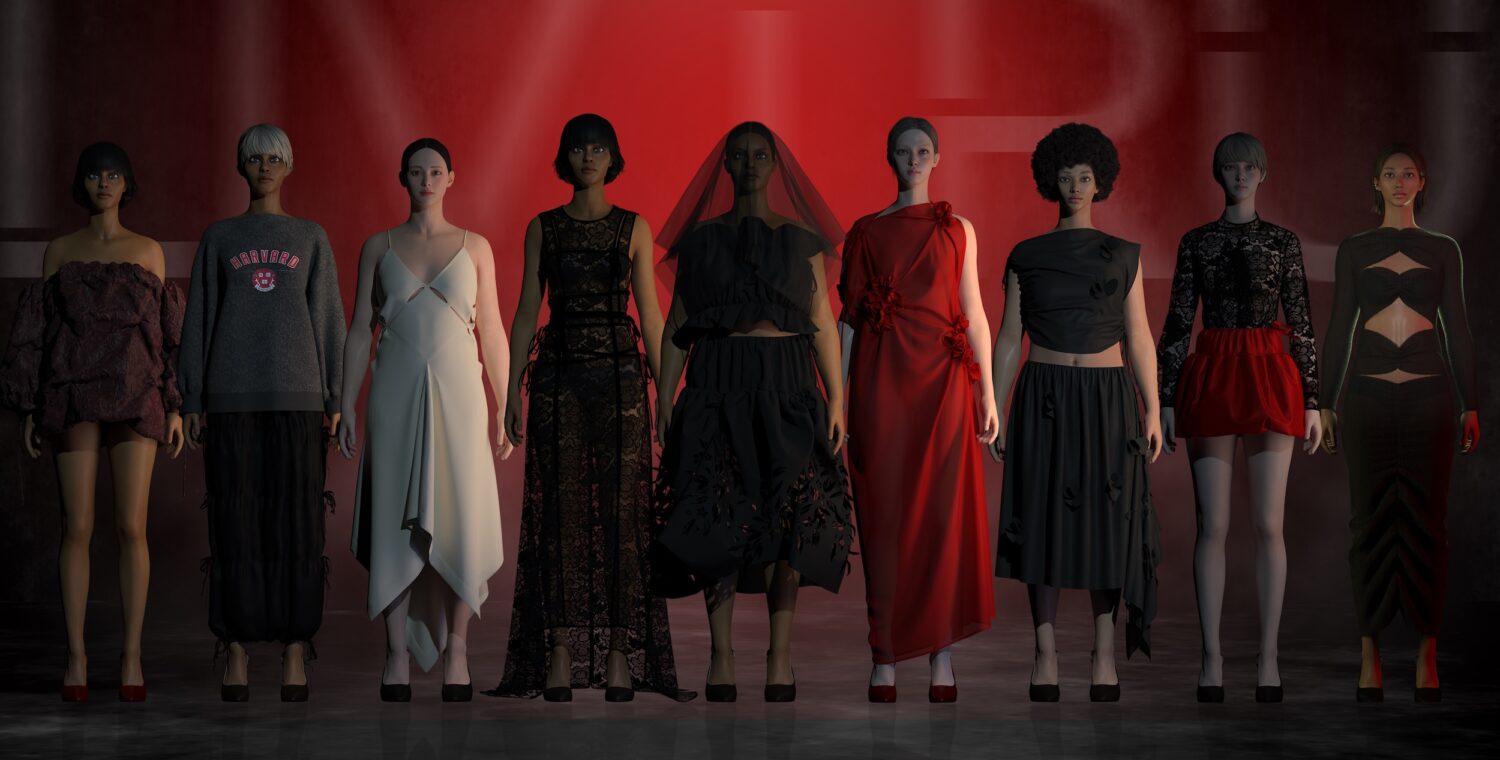3 Interpretations of the Present
In the fashion industry, technology and digital tools are often highlighted as the solution to preserving fashion and its growth despite the significant climate challenges posed by the industry. We are currently in the Anthropocene era, where the current paradigm of fashion significantly contributes to the human-induced transformations of our ecosystems and the impact of human behavior on our planet. The Anthropocene era is a historical context and a geological term denoting environmental changes caused by human activity (Brooks et al., 2017, Payne, 2017).
Political theorist Lars Tønder (2019) describes three interpretations of the Anthropocene era or epoch:
The dystopian interpretation, where humans believe in themselves, and their destructive behavior leads to the downfall of humanity. It’s a pessimistic view of humanity’s inability to change and respect forms of life other than human.
The Promethean interpretation, named after the god Prometheus, where human’s ability to create knowledge and use technological advancements enables progress and control over climate change. An optimistic view of humanity’s ability to change the world through technology.
The Gaian interpretation, named after the goddess Gaia, where the human and ‘non-human’ are connected, giving rise to new forms of ecological coexistence among all forms of life. Thus, this interpretation becomes a blend of pessimism and optimism about the future in the Anthropocene era (Tønder, 2019: 733-737).
Fashion Overconsumption and Overproduction
The human-induced environmental changes are largely a consequence of our ever-increasing consumption of products – from digital gadgets to clothing – where the production, use, and disposal of products pose an increasingly significant threat to our environment and planet. We use products to create our identity, and within products, our clothing is a highly visible part of our social identity; our attire is one of the most visible forms of consumption and plays a significant role in the social construction of identity (Crane, 2000:1).
As clothing is one of the most visible forms of consumption, it also becomes a conspicuous example of the (over)consumption that influences contemporary environmental changes. Therefore, the fashion paradigm is an interesting area to discuss in the context of the Anthropocene era, especially with the Promethean interpretation, where new technological possibilities (perhaps) enable the control of climate change.
The current paradigm of fashion can be briefly described as a paradigm dominated by overconsumption and overproduction, with a focus on low prices, rapid product turnover, and an average of few uses per product, resulting in a large amount of clothing discarded before it has exhausted its physical utility. Estimates show that 1/3 of produced clothing ends up directly as waste without meeting a user, 1/3 is sold at reduced prices, and only 1/3 is sold at full price (Ninimäki et al., 2019).
How New Technology Perpetuates Old Habits
Researchers in fashion and textiles also address the interpretations associated with the Anthropocene era. They critically focus on two different perspectives in the approaches used within the fashion industry concerning the reduction of the industry’s environmental footprint. Similar to Tønder, ‘techno-optimists’ are addressed, who believe that new technologies can contribute to a future where we will see a development towards a better and cleaner industry, thus largely maintaining our current fashion paradigm, where the production and consumption of clothing contribute to continuous growth in what is highlighted as a ‘good Anthropocene’ epoch in a Promethean interpretation.
As a counterpoint to the ‘techno-optimists,’ we find those of us who are more skeptical (or doubtful) about technology as the solution, whom I choose to call ‘techno-skeptics.’ ‘Techno-skeptics’ do not reject the potentials within technology but emphasize the imperative need to focus on entirely new approaches to both production and consumption to fundamentally change the fashion paradigm and free fashion from the unsustainable growth imperative of capitalism.
From the perspective of ‘techno-skeptics,’ the possibility of a ‘good Anthropocene era’ does not exist, and the criticism of the significant focus on technology as a solution to fashion challenges stems from the tendency of ‘techno-optimism’ to want to maintain the current mechanisms of fashion through technological solutions, rather than contributing to a different approach where the focus is on reducing production and consumption of fashion (see, e.g., Payne, 2017, Brooks et al., 2017).
New Technology Boosts Fast-Fashion Sales
In recent years, the fashion industry has witnessed several initiatives using various new technologies to create different fashion or fashion in a different way. The digital fashion house ‘The Fabricant,’ established in the Netherlands in 2019, develops and sells digital fashion as NFTs under its own name and in collaborations with other brands such as ‘Under Armour’ and ‘Off-White,’ among others.
One might initially imagine that the offering of digital fashion could contribute to reducing the number of physical products introduced into the world, such as an alternative to physical products by ‘SoMe’ influencers. However, it appears that fashion NFTs do not replace physical products but, on the contrary, create new revenue streams for large established companies.
According to Forbes, Gucci, for example, leverages NFTs as an opportunity to boost the sales of physical goods while simultaneously selling virtual versions of their products to users in the metaverse. Thus, these digital fashion offerings hardly contribute to reducing the environmental footprint of the fashion industry; instead, they align with the current fashion paradigm of more of everything, thereby reinforcing capitalism’s focus on growth.
Another ‘techno-optimistic’ example from the fashion industry is the implementation of 3D tools, such as CLO 3D, which is increasingly used in the industry and is also becoming widespread in the Danish fashion industry, gradually becoming part of the curricula of design schools.
3D tools have the advantage that design proposals can be visualized in a relatively lifelike manner, and, therefore, it is expected that companies can reduce their ‘sample production,’ which is highlighted as a contribution to reducing the industry’s environmental impact. However, this becomes a somewhat hollow claim as the industry’s production of products and, therefore, the consumption of resources is still increasing. Clothing sales are rising both nationally and in export markets; for instance, exports to Sweden and Germany increased by 39% in 2022 according to Deloitte.
Calculation of Environmental Impact is Missing
3D tools are also considered to open up new possibilities in online commerce, where the use of avatars and 3D visualizations as a communication tool is believed to contribute to reducing the volume of returned goods, a major environmental challenge in online commerce.
According to Deloitte, returns still pose a significant challenge in online commerce. Besides not being able to register reductions in the fashion industry’s environmental impact in terms of the number of products or the number of returns in online commerce, we also lack specific calculations of the environmental impact arising from the use of 3D tools, where, for example, measuring CO2 emissions in the use of these tools is relevant.
One challenge in achieving the full effect of the potential of 3D tools as a contribution to reducing environmental impact is that the tools are mainly used to develop products with the same standards and in the same linear processes that have dominated the fashion industry in recent decades, making 3D tools ‘just’ new tools that replace or complement previous tools.
The Potential of Technology is Not a Quick Fix
In addition to measures directly related to the EU’s Eco-design regulation, such as long-lasting products and recycled/recyclable materials, there are additional measures highlighted as potential contributions to reducing the fashion industry’s environmental impact with a focus on different approaches to the companies’ product portfolios.
This can include a strategic approach to inclusive collection building or the implementation of ‘mass customization.’ In the use of inclusive collection building, for example, one can work with various body types within the same collection without expanding the collection sizes. This means that the product offering can extend beyond the standard perception of bodies dominating the current fashion industry, which can contribute to more products actually finding a buyer (Terkildsen & Pedersen, 2023).
If avatars representing various body types, not just different sizes, are used, 3D tools can be a useful tool to test to what extent different silhouettes and design elements work on different body types. 3D tools should be seen as a new tool in the designer’s toolbox, and the use of 3D tools requires in-depth knowledge of product development. Basic design competencies in aesthetics, materials, craftsmanship, construction, product knowledge, and user understanding are crucial in relation to working with 3D tools.

Therefore, technology, including 3D tools, cannot be perceived as a ‘quick fix’ or a ‘technology fix’ that can replace ‘traditional’ knowledge, craftsmanship, and competencies in design and craftsmanship or ensure that the fashion paradigm can be maintained in its current form in a greener and cleaner version.
We can only change the current fashion paradigm if we change our approach to the production and consumption of fashion, focusing on reducing the number of products (and thus resource consumption) and aiming to create balance with our ecosystems and our planet. Technology can complement some of the tools we can use to ensure that these changes occur.
Sources
The Anthropocene era
Brooks, A. Fletcher, K. Francis, R., Rigby, E., Roberts, T. (2017) Fashion, Sustainability, and the Anthropocene, Utopian Studies, Vol. 28, No. 3, pp. 482-504
Engholm, I. (2023) Design for the New World. From Human Design to Planet Design. Intellect Books
Fletcher, K. & Tham, M. (2019) EARTH LOGIC. Fashion Action Research Plan. THE J J CHARITABLE TRUST
Niinimäki, K., Dahlbo, H., Peters, G., Perry, P. (2020) The environmental price of fast fashion. Nature Reviews | Earth & Environment volume 1. pp:189-200
Payne, A. (2017), Fashion Futuring in the Anthropocene: Sustainable Fashion as “Taming” and“Rewilding”Fashion Theory, Volume 23, Issue 1, pp. 5–23. DOI: 10.1080/1362704X.2017.1374097
Tønder, L. (2019). Det antropocæne. Ny kulturteori. red. / Birgit Eriksson; Bjørn Schiermer. København : Hans Reitzels Forlag, . s. 723 – 751
Other sources
https://www.forbes.com/sites/bernardmarr/2022/11/30/gucci-enters-the-metaverse/
https://www2.deloitte.com/dk/da/pages/brancheanalyser/modeanalysen.html
Terkildsen, M. & Pedersen, L. (2023) Inclusive Design & Fit Management, Kapitel i Sustainability in Creative Industries – Perspectives from the field of education and business, editors Østergaard, T., Bang A.L: & Clausen, R.T.J., 1. udgave, 1. oplag, 2023, Frydenlund, ISBN 978-87-7216-596-7
Theme: Crafted Realities
How are the infinite and impactful possibilities of the digital realm utilized? Formkraft explores what the digital state means for the craft and design sector. How can craftsmen and designers best harness the new digital tools, and what pitfalls should they avoid? Read theme


